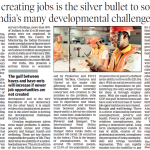 The Arab Spring, the uprising that rapidly spread through the Middle East in 2010-11, can be attributed to long-simmering discontent resulting from unworthy employment. When the Arab Spring was triggered, one in every four young Egyptian and Tunisian was unemployed. Closer home, we have seen the results of unemployment bubble over many times.
The Arab Spring, the uprising that rapidly spread through the Middle East in 2010-11, can be attributed to long-simmering discontent resulting from unworthy employment. When the Arab Spring was triggered, one in every four young Egyptian and Tunisian was unemployed. Closer home, we have seen the results of unemployment bubble over many times.
In 2016, just a week-long agitation in north India is estimated to have resulted in economic loss of between Rs 20,000 to Rs 34,000 crore – providing a realistic view of what unrest can unleash. Inability to find jobs matching education undertaken is a big issue today. The nation’s education system seems to have created an army of unemployable graduates, leading to insecurity and unemployment. This scenario has repeated itself in the last couple of years.
While India’s economy has been growing, job creation has not kept pace. Unemployment has been on the rise. The results of the Organisation of Economic Cooperation and Development (OECD) India Economic Survey 2017 reflect this. According to the survey’s findings, more than 30% of Indians in the 15 to 29 years age group were not employed. In March 2018, the Centre for Monitoring the Indian Economy made unemployment figures more tangible. CMIE found that there were about 31 million unemployed youth in India as of February 2018. In relation, job creation in 2018 was estimated to be a mere 600,000.
For India, this presents a serious threat to economic development and to the very foundation of our democracy. On the other hand, it is amply evident that employment generation is the silver bullet to solving the developmental challenges faced by India.
Creating employment solves three major problems. It addresses social unrest and crime; poverty and hunger; health and wellbeing. These are key factors responsible for quality of life. They determine the stability of a nation.
Social unrest: The sixth edition of the India Risk Survey released by Pinkerton and FICCI ranked ‘Strikes, Closures and Unrest’ as the major risk affecting the Indian economy. Businesses are naturally concerned. Job creation is the antidote to the problem. Jobs bring people together, allow everyone to experience new ideas, build self-esteem and increase trust between people. More importantly a job turns citizens into conscious stakeholders in the future, driving stability.
Poverty and hunger: The International Food Policy Research Institute’s Global Hunger Index ranks India at number 100 (with 119 countries in the index). This is the impact of unemployment. In 2015 around 170 million people, or 12.4% of the population, continued to live in poverty (defined as the ability to live on Rs 123.50 a day). With no social security and a complete dependence on philanthropy, the only escape route for them is through employment. With the rapid growth in GDP, the gulf between haves and have-nots will increase if newer job opportunities are not created.
Health and well-being: There is a direct relationship between unemployment, poverty and health. Poverty and poor health reinforce unemployment, triggering a downward spiral. Long term unemployment results in loss of skills, erosion of the professional network, strengthens the perception of being unemployable and brings inevitable depression. This can rapidly escalate into the inability to pay for medical insurance or address family healthcare needs. It is essential that early steps be taken to break the unemployment-povertyhealth cycle by creating programmes that make the unemployed productive – so that they can access regular income, stay healthy and contribute to GDP.
If visible employment opportunities are created, families will be incentivised to invest in education. The rewards can be substantial: The World Bank says that each additional year of education has the power to increase wages by 10%. In addition, policy makers must bear in mind that the traditional approaches to job markets have taken a dramatic turn, calling for newer thinking. For example, the informal sector is giving birth to a new breed of successful and respected entrepreneurs. Also, upskilling the existing workforce with skillsets for disruptive industries and jobs of the future is a new dimension.
The bottom line is clear: job creation is the solution. But the relationship between growth, employment and education is a complex one calling for careful deliberation.
Atul Raja is Executive Vice-President, Global Marketing at Wadhwani Foundation
Additional coverage links:
Economic Times
Times of India

